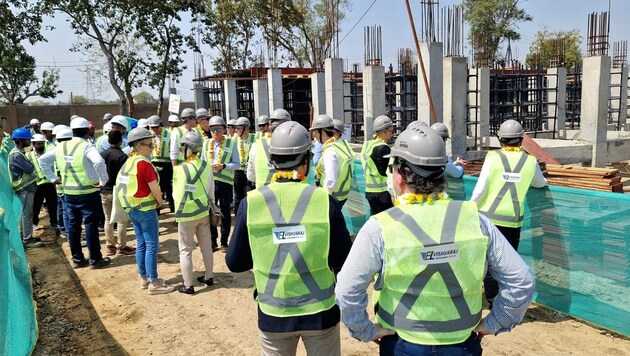Huge task
Indians go for red-white-red when it comes to environmental protection
When it comes to nature conservation, there is still a lot of room for improvement in India, to put it charmingly. 62 million tons of waste are produced every year, most of which simply ends up on the streets or pollutes the rivers. The giant country now wants to learn from comparatively small Austria in this area.
Around seven million people visit the Taj Mahal every year. Built by Grand Mughal Shah Jahan for his deceased (main) wife Mumtaz Mahal, the mausoleum still fascinates visitors from all over the world with its sheer immaculate beauty almost 400 years after its completion. Less appealing to the eye is the river that flows by just a few meters from India's most famous sight in Agra.
Only 20 percent of waste is disposed of properly
The Yamuna is not blue or green, but black. The herons that have gathered on the gravel bank beneath the Taj Mahal look sad or even perplexed. You can't really make out any life in the water when you look at the sluggish broth drifting past them. Instead, you keep seeing garbage, from plastic bottles to fridges, floating along because it has simply been dumped in the river. And the Yamuna (which flows into the Ganges after almost 1400 kilometers) is no exception in India; the environment is incredibly filthy. Garbage is usually simply thrown away carelessly, collecting on the side of the road, on former meadows or in rivers. 62 million tons of waste accumulate in this huge country every year. Only 20 percent of this waste is disposed of properly.
However, environmental protection is slowly but surely becoming an issue on the subcontinent and the government has recently set several priorities in this regard. One of these is sewage treatment plants to detoxify the rivers, as pollution does not even stop at the holy rivers such as the Ganges, Saraswati, Godavari, Krishna, Brahmaputra, Narmada and Yamuna. One of these water treatment plants is being built in Agra. With Austrian technology and financing - the red-white-red development bank provided a loan of 35 million euros for this project - the water supply for the 2.5 million inhabitants in the region is to be ensured within two years.
Bernhard Puttinger, Managing Director of the Styrian Green Tech Cluster, also gained an impression of India's environmental ambitions at the construction site of the huge wastewater treatment plant. "There are two major issues in India in this area. Firstly, electrification with the associated differentiation from China and then green hydrogen, where several plants have already been built." He sees great potential for Styrian companies in this area. "The growth rates in this area here are more than ten percent. And yes, we have the know-how and expertise to get involved here."
Styrian wood for the Indian market
Wood specialist Teuschler from Bad Walterdorf is also focusing on a natural product. "So far, India has basically been a low-cost market. However, due to the current transformation, the middle class is also growing in this country of billions," Managing Director Arno Teuschler is convinced. The East Styrians want to win over this new middle class with their high-quality niche products. "Prosperity will continue to grow, so there is huge potential here."
However, the delegation trip to India is only the first step for the white-green economy. "The focus on India is currently set for three years, but can then of course become permanent," explains programme manager Christina Ulrich from the Internationalization Center Styria (ICS). "Many companies are currently looking for an alternative to Russia. The market in India is challenging, but at the same time has incredible growth rates in a comparatively politically stable environment." The ICS aims to prepare Styrian companies for the Indian market with workshops on customs and imports or the peculiarities of employee management on the subcontinent.
The Styrian delegation's trip ended on Thursday with a white-green evening at the Austrian Embassy in New Delhi. Ambassador Katharina Wieser also gave the companies on the trip an in-depth overview of India, and the international guests were treated to Styrian specialties such as fried chicken, pumpkin seed oil and wine.














Da dieser Artikel älter als 18 Monate ist, ist zum jetzigen Zeitpunkt kein Kommentieren mehr möglich.
Wir laden Sie ein, bei einer aktuelleren themenrelevanten Story mitzudiskutieren: Themenübersicht.
Bei Fragen können Sie sich gern an das Community-Team per Mail an forum@krone.at wenden.